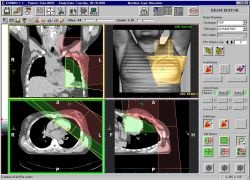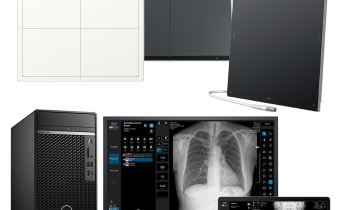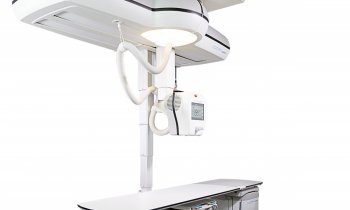3-D simulation
streamlines radiotherapy
Exomio, a new simulation technique, improves the accuracy of radiation therapy and reduces treatment planning time to a matter of minutes, according to scientists at the Fraunhofer Institute for Computer Graphics Research IGD, who developed the system with industrial partners MedCom GmbH and Medintec GmbH. They also report that the product has obtained worldwide clinical approval and that 60 clinics in 19 countries are now using the system, including the radiation clinic in Offenbach, Germany, and the Tubingen's University Hospital.

When radiotherapy is the choice of treatment for a cancer patient, physicians use the medical case history and computer tomography data to determine the number, position and intensity of the radiation beams to be applied.
A large amount of preparatory work involves simulating the radiation therapy using low-power x-ray beams, says Professor Georgios Sakas of the IGD. ‘During this, a patient must remain completely immobile on an examination table for up to an hour. ‘Even the slightest movement could compromise the accuracy of the ensuing treatment - every millimetre counts,’ he adds. Sites for treatment are drawn on the patient’s skin with an indelible marker pen. These outlines must not be changed or washed off for the duration of treatment, which may last many weeks and cause considerable inconvenience for a patient and incur high personnel and other costs.
Using the new technique a physician simulates treatment realistically and accurately, based on computerised CT data, which does not tie up medical resources - and a patient need not be present. ‘Exomio has a simple, intuitive user interface that enables a physician to evaluate 3-D images as easily as conventional X-ray images,’ says Professor Sakas. ‘The greatest advantage is that preparatory simulation offers more flexibility in the siting and number of areas to be targeted by the radiation source.’ Without the patient’s presence, a physician can study individual tumours and experiment with various alternative treatment plans before deciding the best choice. ‘After simulation, the prepared therapy plan is passed to the radiologist who calculates the required doses.’
Modification of the beam angle can improve the accuracy of the radiation treatment and the ability to lower or raise the dose and limit damage to healthy tissue benefits the patient’s well-being and prospects for recovery. Professor Nikos Zamboglou of the Offenbach radiation clinic also adds: ‘This software allows us to show patients what the therapy involves, how it works, and where the radiation treatment will be applied, which helps them to better understand and thus place more trust in the therapy.’
In October, the Exomio, which runs on a standard high-performance PC, gives superior results and improves treatment costs without major investment, was voted a finalist out of 600 other IT projects in the ‘Health’ category of the prestigious Stockholm Challenge Award.
Details: www.igd.fhg.de/igd-a7/index.html
01.07.2003











